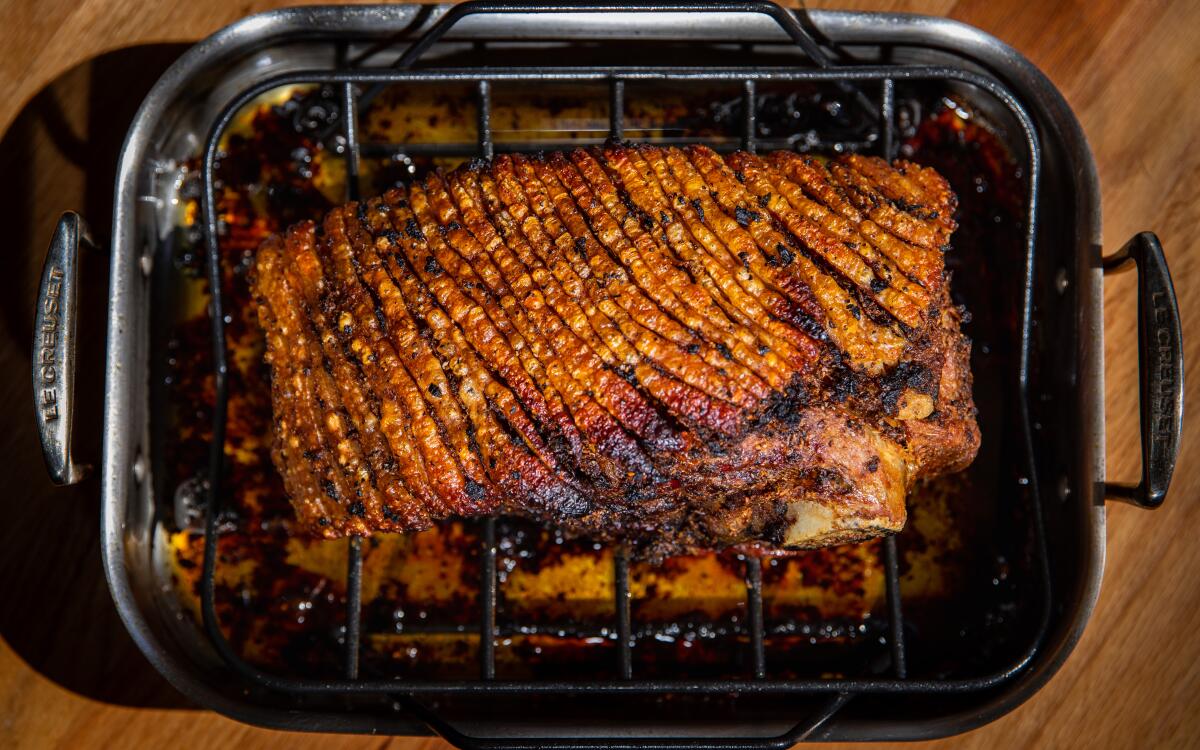Crackling Roast Pork Shoulder With Fennel and Chile

- Share via
At Peads & Barnetts Farm, Oliver Woolley draws on his family’s British heritage for cooking pork shoulders via a classic recipe from The River Cafe in London. “My entire family has been cooking this dish for years,” says Woolley. “The roasted pork is fantastic served with white beans like cannellini and some simple braised greens.”
It’s an Italian-style treatment that utilizes fennel seeds and pollen, chiles, garlic and lemon in a fragrant rub that coats a scored skin-on pork shoulder. The blast of high heat at the beginning of cooking puffs the skin and transforms it into crisp crackling to complement the soft meat underneath. Woolley cooks the roast in a Big Green Egg, but you can easily replicate his results in another outdoor smoker, charcoal grill or your home oven.
This pork takes at least 14 hours to cook, so plan accordingly. I’ve found the best approach is to put the pork in the oven right before you go to bed, so it is finished cooking around lunchtime the next day; otherwise, you will have to wake up before sunrise to get it started so it’s ready by dinnertime. Either way, check on the pork every hour after seven or eight hours because, if your oven is like mine, it might shut itself off after so many hours at such a low temperature. Trust me, you don’t want to find this out the hard way.
Remove the pork from the refrigerator 1 hour before you plan to cook it so it has time to come to room temperature; this allows for more even cooking. Place the pork, skin side up, on a rack set inside a large roasting pan (or use a wire rack set in a rimmed baking sheet). Arrange your oven racks in the lower third of your oven and heat the oven to 500 degrees.
Meanwhile, dry the skin well with a paper towel. Using a razor blade or very sharp paring knife, score the skin every 1/4 inch, cutting through the skin and fat but not deep enough to cut the meat. Generously season the skin with some salt and rub the salt into the cuts.
Place the fennel seeds in a large mortar and pestle and pound until finely ground (or place the seeds in a plastic bag, seal and use a heavy skillet to crush the seeds through the bag). Stir in the fennel pollen, chile flakes and 1 tablespoon salt. Add the garlic cloves and smash each to break apart, then grind against the mortar to create a mostly smooth paste (or grate them to a pulp on a microplane grater). Using a microplane grater, grate the zest from 1 lemon into the mortar and mix it into the paste along with 1/4 cup olive oil; reserve the lemon.
Using your fingers, rub the fennel-garlic paste all over the meat and in the scored lines of the skin, making sure to rub it into the fat under the scored skin. Brush as much excess paste off the skin as possible so it doesn’t burn in the oven. Season the pork liberally with more salt and pepper until fully coated. Reposition the pork, skin side up, on the rack.
Place the pork in the oven and roast, rotating the pan halfway through cooking, until the skin starts to blister and puff, about 30 minutes. Meanwhile, juice all 4 lemons; you want about 3/4 cup juice.
Remove the pan from the oven (if your oven isn’t spotless, it might get smoky, so prepare for your smoke alarm to go off) and reduce the oven temperature to 250 degrees. Pour 2 cups water into the pan (stand back because it will splatter and hiss) and then pour half the lemon juice over the pork, followed by the remaining 2 tablespoons olive oil. Return the pork to the oven and continue roasting until the meat is very soft when prodded with your finger and the skin is rendered and crisp, 12 to 14 hours, basting with the remaining lemon juice every few hours.
Remove the pork from the oven and let rest at least 30 minutes or, preferably, 1 hour. Serve each person some of the crisp skin and meat cut from different parts of the shoulder.
Get our Cooking newsletter.
Your roundup of inspiring recipes and kitchen tricks.
You may occasionally receive promotional content from the Los Angeles Times.
















